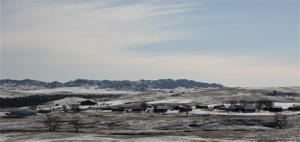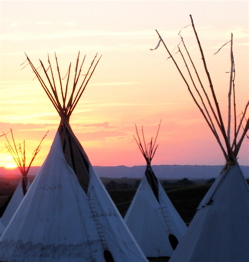Pine Ridge rising: Community-based development project
Published by the Huffington Post in 2011. For more on topics like this, see my book, American Apartheid: The Native American Struggle....
 Economic development has been attempted at Pine Ridge. Why would this endeavor succeed where others have failed? According to the project's attorney, Brett Lee Shelton, previous models were targeted not at growth, but at assimilation. Since Oglalas have about as much affection for forced acculturation as they do for the Seventh Cavalry, the schemes inevitably collapsed. "Thunder Valley's funders were creative in taking the community into account," said Shelton, a tribal member and partner in the law firm Smith Shelton Ragona. "This project arises from the people."
Economic development has been attempted at Pine Ridge. Why would this endeavor succeed where others have failed? According to the project's attorney, Brett Lee Shelton, previous models were targeted not at growth, but at assimilation. Since Oglalas have about as much affection for forced acculturation as they do for the Seventh Cavalry, the schemes inevitably collapsed. "Thunder Valley's funders were creative in taking the community into account," said Shelton, a tribal member and partner in the law firm Smith Shelton Ragona. "This project arises from the people."
 Thunder Valley promotes synergy not just between agencies, but also between tradition and innovation. "Community members approach this project as an expression of what it means to be Lakota in the 21st century," Moore observed. One traditional activity that's being revived is, simply, planning. "Looking forward is not new for us," Tilsen said. "What's new is that nowadays we live day to day, crisis to crisis. Our people never have a moment to consider the future."
Thunder Valley promotes synergy not just between agencies, but also between tradition and innovation. "Community members approach this project as an expression of what it means to be Lakota in the 21st century," Moore observed. One traditional activity that's being revived is, simply, planning. "Looking forward is not new for us," Tilsen said. "What's new is that nowadays we live day to day, crisis to crisis. Our people never have a moment to consider the future."
 Harbingers of success abound, including the enormous energy and good will of the Oglala people. "Lakota culture is inclusive," said Shelton. "The more this project reaches out, the more it honors that. There's room for everyone, including non-Indians living on the reservation. The more, the better."
Harbingers of success abound, including the enormous energy and good will of the Oglala people. "Lakota culture is inclusive," said Shelton. "The more this project reaches out, the more it honors that. There's room for everyone, including non-Indians living on the reservation. The more, the better."
Text c. Stephanie Woodard; photos courtesy Thunder Valley Community Development Corporation.
Oglala Lakota community leader, Nick Tilsen, envisions a vibrant future for his people. He sees elements of that transformation already in place on the Pine Ridge Indian Reservation. However, they need stitching together, like a quilt whose diverse and colorful pieces are scattered -- unseen and uncelebrated -- all over the Oglala Sioux Tribe's homeland in southwestern South Dakota. "There's been economic activity around the reservation, but no way to pull it together," said Tilsen.
Until now. A new Housing and Urban Development grant will help the four-year-old organization Tilsen runs, Thunder Valley Community Development Corporation, do just that. HUD spokesperson Brian Sullivan called the project "exciting" and "a well-rounded regional plan." The funding -- nearly a million dollars -- comes out of HUD's Office of Sustainable Housing and Communities, formed to reduce bureaucratic barriers and involve local people in the development process, said Sullivan. The office encourages grassroots innovation, and Thunder Valley is delivering that right out of the gate, according to Tilsen.
For starters, Tilsen and his colleagues have flipped the power dynamic. "This is not the federal government's plan. It's our plan: the collective vision of the Oglala people. They work for us," said the 28-year-old Tilsen, who credits his parents, who met at the 1973 takeover of Wounded Knee, for his activism.
 Economic development has been attempted at Pine Ridge. Why would this endeavor succeed where others have failed? According to the project's attorney, Brett Lee Shelton, previous models were targeted not at growth, but at assimilation. Since Oglalas have about as much affection for forced acculturation as they do for the Seventh Cavalry, the schemes inevitably collapsed. "Thunder Valley's funders were creative in taking the community into account," said Shelton, a tribal member and partner in the law firm Smith Shelton Ragona. "This project arises from the people."
Economic development has been attempted at Pine Ridge. Why would this endeavor succeed where others have failed? According to the project's attorney, Brett Lee Shelton, previous models were targeted not at growth, but at assimilation. Since Oglalas have about as much affection for forced acculturation as they do for the Seventh Cavalry, the schemes inevitably collapsed. "Thunder Valley's funders were creative in taking the community into account," said Shelton, a tribal member and partner in the law firm Smith Shelton Ragona. "This project arises from the people."
Attending the grant's recent kick-off meeting in their new supportive role were federal, state, and tribal agencies, some of which have long tried to control Oglalas' fate, with often devastating results for tribal members. Other attendees included Lakota Funds, Pine Ridge Area Chamber of Commerce, and the award-winning architecture firm Berkebile Nelson Immenschuh McDowell, or BNIM, which has worked on the reservation for several years and will design housing and plan enterprise zones, among other tasks.
Elders provided guidance, and everyone began thinking outside the box, according to BNIM project manager and architect Scott Moore. "Government officials had a breakout session and talked about collaborating across agencies," said Moore. "They got excited about working together."
 Thunder Valley promotes synergy not just between agencies, but also between tradition and innovation. "Community members approach this project as an expression of what it means to be Lakota in the 21st century," Moore observed. One traditional activity that's being revived is, simply, planning. "Looking forward is not new for us," Tilsen said. "What's new is that nowadays we live day to day, crisis to crisis. Our people never have a moment to consider the future."
Thunder Valley promotes synergy not just between agencies, but also between tradition and innovation. "Community members approach this project as an expression of what it means to be Lakota in the 21st century," Moore observed. One traditional activity that's being revived is, simply, planning. "Looking forward is not new for us," Tilsen said. "What's new is that nowadays we live day to day, crisis to crisis. Our people never have a moment to consider the future."
The level of crisis is staggering, with daily privations that are unimaginable off the reservation. People on Pine Ridge struggle just to survive, said Shelton: "They try to make a living as craftspeople, hunting and wildlife guides, and more, but there's no funding or infrastructure to support them." There are no banks to make personal or business loans and minimal public transportation to move goods and services and ensure employees get to work safely; automobiles may injure or kill pedestrians and horseback riders traveling roads without shoulders or sidewalks. Because dollars arriving on Pine Ridge land in a matter of hours in off-reservation businesses, such as grocery and clothing stores, the tribe has, in essence, barely any economy. These problems are exacerbated by 80-90 percent unemployment, minimal access to safe water and fresh food, a severe housing shortage, and extreme rates of chronic illness and suicide.
Our economy reflects our history," said Tilsen. "It's as though a tornado came through. A tornado of colonization, of oppression. But by asking what happened, we produce healing and progress."
 Harbingers of success abound, including the enormous energy and good will of the Oglala people. "Lakota culture is inclusive," said Shelton. "The more this project reaches out, the more it honors that. There's room for everyone, including non-Indians living on the reservation. The more, the better."
Harbingers of success abound, including the enormous energy and good will of the Oglala people. "Lakota culture is inclusive," said Shelton. "The more this project reaches out, the more it honors that. There's room for everyone, including non-Indians living on the reservation. The more, the better."
The inclusiveness extends to the economic model, according to Tilsen: "Our people want to trade or participate in the cash economy, as needed. Some want a 30-year mortgage; others want to use local natural materials, as in straw-bale construction, to build homes with their own hands. We support all their choices."
Job one for Thunder Valley CDC is collecting data -- about current reservation homes and building projects; existing roads and utilities; tribal members' travel and spending patterns; the reservation's natural assets; and much more. Moore called information gathering the basis of smart growth and of a process that'll outlast current participants.
Said Tilsen: "It'll last as long as the people embrace it."
Text c. Stephanie Woodard; photos courtesy Thunder Valley Community Development Corporation.

